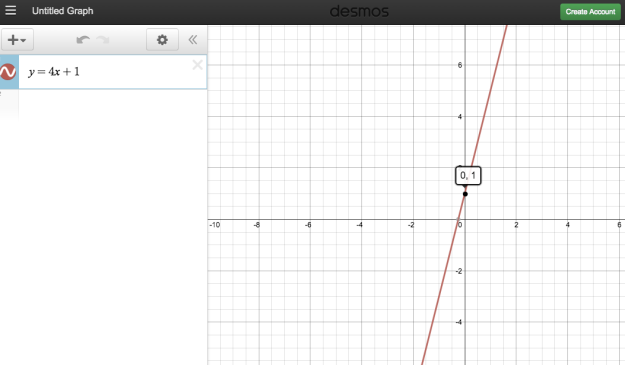
I have been running a ‘visual pattern’ every week with my 6th grade (pre-Algebra) classes. You can read more about this here.
To bridge the gap between pattern and function and following an online course I took with Rice University, I have started to introduce some basic coding. Python in particular. Even after one lesson of using coding and graphing, I have been able to have rich conversations about the differences between functions, input/outputs, the shape of a graph and the y-intercept. Here is the process I have taken them through:
Part 1: Have the students run through a basic (linear) visual pattern (from visualpatterns.org) using this sheet and reviewing using this slide:

The nth term for this pattern is 4n+1.
Part 2: I now challenge them that we can create a calculator for this pattern using the Python coding language. I use the free python interface CodeSkulptor (from Rice University) to do this. I take them through step-by-step with some great conversations about functions and inputs/outputs.
The nice thing about CodeSkulptor is that when you hit the save button, it creates a brand new URL meaning that each student will have their own URL to post and share.

They can then change the input and see clearly what happens to the output.
(Note: Lines with # are ignored by the interface)
Part 3: They then go to the Desmos Online Graphing Calculator and input the function y = 4x+1 to confirm or deny their prediction for the graph shape, from the start of the exercise. This is a great opportunity to talk about ‘step zero’ (as well as step -10 etc.) and why they graph is the shape that it is. I feel it is also important to stress the difference between 4n+1 as an nth term and y=4x+1 (which includes everything in between).

Their homework is simply to follow the steps with a different (linear) visual pattern and to share their CodeSkulptor URL’s and Desmos screenshots on the class’ wiki page.
For student assistance I created this video:
Where Next?
There are two main places that I would like to take this:
- Exponential functions
- Inverse functions
I’m really excited about where this journey will take us. My hope is, that as these students start Algebra proper, next year, they will have a strong sense of functions graphs and their connections with patterns and geometry. Here goes…..
Have you done anything similar? I would love to hear your ideas/thoughts in the comments section, below.
